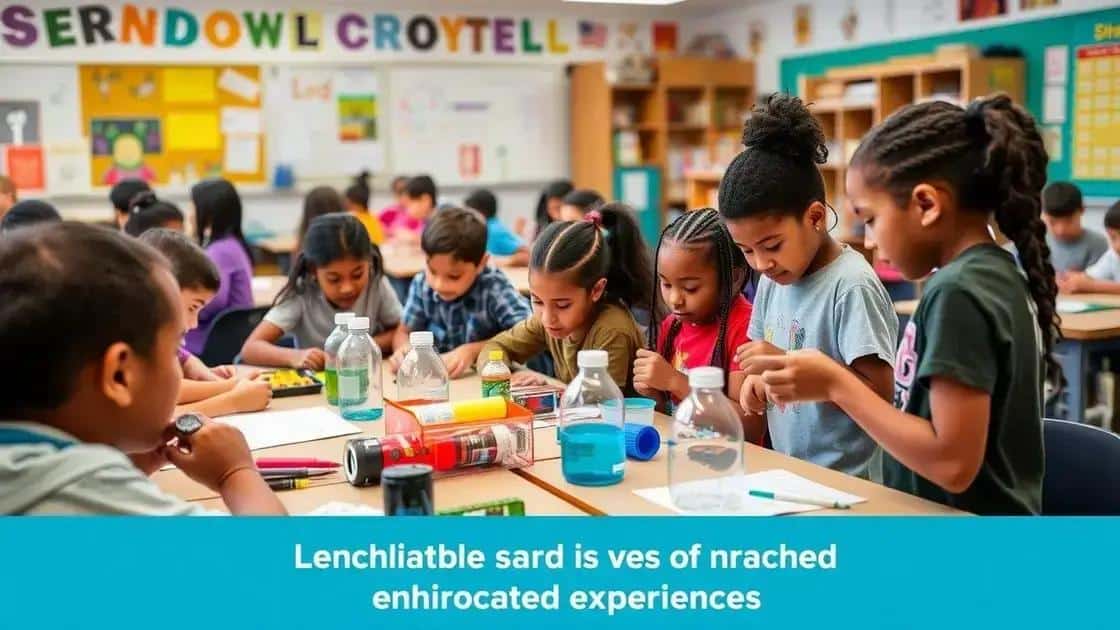Paper curriculum improvement ideas to enhance learning

Curriculum improvement involves enhancing educational strategies through innovative methods, technology integration, and continuous evaluation to better engage students and improve learning outcomes.
Paper curriculum improvement ideas are essential for educators seeking to elevate student engagement and learning outcomes. With an ever-evolving landscape, how can we adapt our approaches to better serve our students? Let’s dive into effective strategies and insights.
Understanding the need for curriculum improvement
Understanding the need for curriculum improvement is crucial in today’s dynamic educational landscape. Schools and educators must continually assess their teaching methods and materials to ensure they meet students’ diverse needs.
Many factors contribute to the necessity of improving the curriculum. For one, student engagement directly impacts academic achievement. If students are not actively participating or showing interest, results can suffer. By refining the curriculum, educators can make learning more relevant and exciting.
The role of feedback in curriculum improvement
Gathering feedback from students, teachers, and parents is essential. Insights from these groups can shed light on what works and what doesn’t.
- Conduct surveys to capture opinions on course materials.
- Host focus groups to discuss curriculum effectiveness.
- Analyze test scores to identify areas needing enhancement.
Another driving force behind curriculum improvement is the evolution of technology. Incorporating new tools can help create a more interactive learning environment.
When educators embrace technology, they can supplement lessons with multimedia resources. This approach not only enriches the content but also helps cater to different learning styles. Therefore, integration of technology is not just a trend; it’s a vital part of modern education.
Identifying gaps in the current curriculum
Regular assessments can highlight specific areas needing attention, such as outdated information or ineffective teaching methods. Teachers should ask themselves how to stay current and relevant.
- Evaluate state and national standards.
- Review audiovisual resources for contemporary relevance.
- Modify lesson plans based on recent findings.
Ultimately, addressing the need for curriculum improvement leads to a more effective educational experience for all. It ensures that students are prepared not just for tests, but for life.
Innovative strategies for curriculum design
Innovative strategies for curriculum design can significantly enhance student learning experiences. By integrating fresh ideas and techniques, educators can create a dynamic environment that keeps learners engaged and motivated.
One effective approach is to apply project-based learning (PBL). PBL allows students to explore real-world problems, fostering critical thinking and collaboration. Through this method, students work on projects that reflect their interests while aligning with learning objectives.
Benefits of project-based learning
Implementing project-based learning can have lasting impacts on students. Some benefits include:
- Enhances problem-solving skills.
- Promotes teamwork and communication.
- Encourages self-directed learning.
Another innovative strategy is the use of blended learning. This method combines traditional classroom instruction with online resources, allowing students to learn at their own pace. Blended learning provides flexibility, catering to various learning styles and schedules.
Integrating technology in curriculum design
Incorporating technology into the curriculum is essential for modern education. Tools like digital simulations and interactive apps help create engaging lessons. When technology is effectively integrated, it can transform how students interact with content and deepen their understanding.
Moreover, the use of gamification in education presents an exciting avenue for enhancing curriculum design. By applying game-like elements to lessons, educators can boost motivation and engagement. Students often enjoy competing for points or badges, which makes learning more enjoyable. As a result, gamification can lead to improved academic performance.
Ultimately, the goal of employing innovative strategies is to create a curriculum that is responsive to student needs. By continually adapting and evolving, educators can ensure that learning remains relevant and effective.
Real-world examples of curriculum enhancements

Real-world examples of curriculum enhancements provide valuable insights into effective teaching practices. Educators can learn from successful implementations that have positively impacted student learning.
One notable example is the integration of STEM (Science, Technology, Engineering, Mathematics) programs in schools. These programs promote hands-on learning and engage students in critical thinking. In many cases, schools that adopted STEM curricula reported increased student interest in these subjects, leading to higher enrollment in related courses.
Case study: A successful STEM program
Many schools across the country have transformed their curricula by including STEM-focused projects. Benefits of these programs include:
- Improved problem-solving skills among students.
- Collaboration between students on engineering challenges.
- Greater awareness of career opportunities in STEM fields.
Another example is the use of inquiry-based learning in classrooms. This approach encourages students to ask questions and explore topics in depth. Teachers guide students through investigations that foster a deeper understanding of the material. Many educators have noticed greater student enthusiasm and motivation when the curriculum includes inquiry-based learning.
Benefits of inquiry-based learning
By adopting this style of learning, teachers can observe several positive outcomes:
- Students develop critical thinking skills.
- Increased engagement in lessons leads to better retention.
- Encouragement of creativity and independence among learners.
Additionally, schools incorporating social-emotional learning (SEL) into their curricula have found it immensely beneficial. SEL focuses on developing emotional intelligence and interpersonal skills. Programs that prioritize SEL interventions help students manage emotions and build better relationships, leading to improved classroom dynamics.
As seen in these examples, implementing effective strategies and real-world enhancements in the curriculum can lead to substantial benefits for students. By continually adapting and improving educational practices, schools can create a more engaging and supportive learning environment.
The role of technology in curriculum improvement
The role of technology in curriculum improvement is becoming increasingly vital. As classrooms evolve, integrating technology can create an engaging and interactive learning environment.
One significant aspect of technology in education is the use of online resources. Students can access a wealth of information beyond traditional textbooks. This availability fosters independent research skills, allowing learners to explore topics that spark their curiosity.
Benefits of online resources
Utilizing online resources in the classroom can lead to numerous advantages:
- Access to diverse perspectives and materials.
- Encouragement of self-directed learning.
- Flexibility to learn at their own pace.
Moreover, technology facilitates collaboration among students. Tools like Google Classroom and Microsoft Teams allow for real-time communication and collaboration. This means students can work on projects together, even if they are not in the same physical location.
Interactive learning experiences
Incorporating multimedia elements, such as videos and interactive simulations, enhances lessons. When teachers use interactive tools, lessons become more engaging. Students can visualize concepts, making complex ideas easier to understand.
Additionally, using educational apps can aid in skill development. Games and quizzes can reinforce lesson content, making learning fun and memorable. By combining learning with technology, educators can create a positive and stimulating classroom atmosphere.
As we see, the integration of technology into curriculum design is essential for modern education. By embracing these advancements, teachers can improve engagement, foster collaboration, and create dynamic learning experiences.
Measuring the impact of curriculum changes
Measuring the impact of curriculum changes is crucial for understanding their effectiveness. Educators must evaluate whether new strategies truly enhance student learning.
One common approach to measure impact is through standardized testing. These assessments can reveal how well students grasp the material. However, relying solely on test scores might not provide a complete picture. It’s important to consider various factors that contribute to learning outcomes.
Qualitative methods for evaluation
In addition to testing, qualitative methods can offer valuable insights. Gathering feedback from students and teachers can highlight the strengths and weaknesses of the curriculum.
- Conduct surveys to collect opinions on the new curriculum.
- Hold focus groups to discuss experiences and perceptions.
- Analyze classroom observations to assess engagement levels.
Another method is tracking student progress over time. By comparing performance before and after implementing curriculum changes, educators can see if improvements occur. This longitudinal approach helps in understanding the long-term benefits of the new curriculum.
Using data to inform decisions
Data analysis plays a key role in determining the success of curriculum changes. Educators can use various metrics to evaluate progress, such as:
- Attendance rates and engagement levels.
- Changes in student behavior and participation.
- Improved grades and completion rates.
Ultimately, measuring the impact of curriculum changes involves combining both quantitative and qualitative methods. By looking at a range of data, schools can make informed decisions. This continuous evaluation helps ensure that the curriculum remains relevant and effective for all students.
FAQ – Frequently Asked Questions about Curriculum Improvement
What are the main benefits of curriculum improvement?
Curriculum improvement can enhance student engagement, foster critical thinking, and ensure that educational content remains relevant and effective.
How does technology impact curriculum design?
Technology facilitates interactive learning, collaboration among students, and access to diverse resources, making lessons more engaging.
Why is it important to measure the impact of curriculum changes?
Measuring the impact helps educators understand the effectiveness of new strategies and make informed decisions for future improvements.
What role do student feedback and surveys play in curriculum enhancement?
Student feedback provides valuable insights into their learning experiences, helping teachers identify strengths and areas that need improvement.






